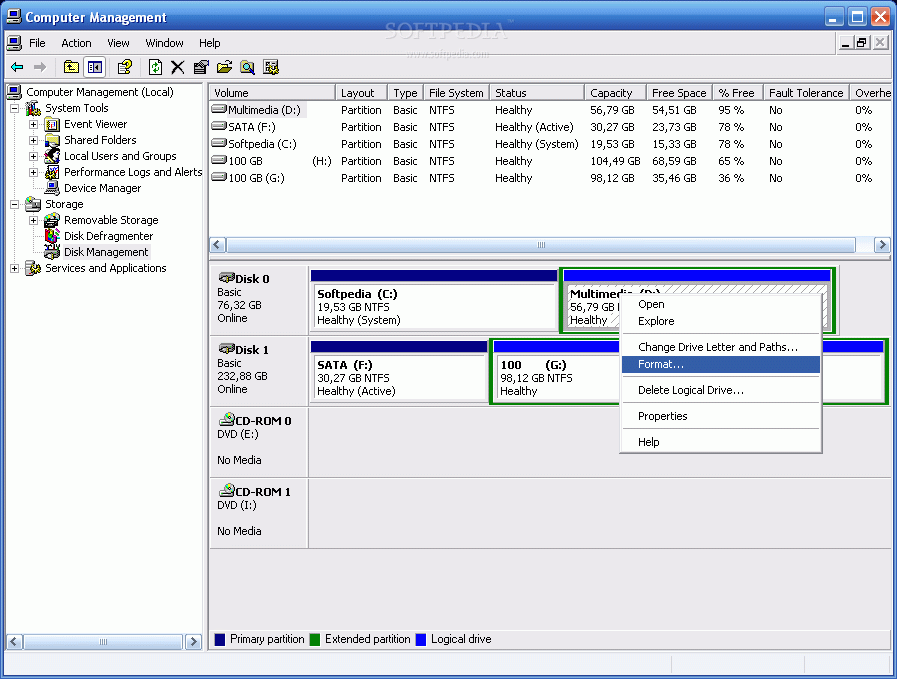

- #Logical volume manager windows how to#
- #Logical volume manager windows software#
- #Logical volume manager windows windows 8#
- #Logical volume manager windows windows 7#
- #Logical volume manager windows professional#
When you have finished all the steps, you can successfully create a logical partition when Disk Management can’t achieve that. Step 3: Then preview the change and click Apply to confirm the change. In addition, you can drag the slide to decide the size of the logical partition and click OK to continue. You need to set this partition as logical. Step 2: Then you need to set some properties such as Drive Letter, File System, and Cluster Size for the new partition. Then select the unallocated space and choose Create from the context menu. Step 1: Launch MiniTool Partition Wizard to enter its main interface.
#Logical volume manager windows how to#
Thus, to create logical partition, download MiniTool Partition Wizard to have a try.Īnd in this part, we will show you how to create logical partition step by step with pictures. With its powerful features, it can help you to migrate OS to SSD without data loss or perform some other actions with ease.
#Logical volume manager windows professional#
MiniTool Partition Wizard is professional partition magic which is designed to optimize partition and disk use. Nevertheless, in order to create a logical partition, you can take advantage of a piece of third-party software, thus MiniTool Partition Wizard would be a good choice.
#Logical volume manager windows windows 7#
Thus, how can you create logical partition Windows 7 when Disk Management can’t? How to Create Logical Partition When Disk Management Can’t?
#Logical volume manager windows windows 8#
For detailed information, please see Can’t Create Partition Windows 8 since both Windows 7 and Windows 8 have the same limitation. When there have been 3 primary partitions and 1 logical partition, you will be unable to create logical partitions with unallocated space. Thus, do you know what the reason is and how to create a logical partition when disk management Windows 7 can’t complete the task?Īs a matter of fact, if you are creating partitions with Disk Management Windows 7, Primary or Logical is not provided for you to choose, and the tool just sets it by default. However, when you are creating a new logical partition with Disk Management Windows 7, you will receive the following the message: Then you are planning to shrink partition E so as to create a new logical partition. And the first 3 partitions are primary and the last one is logical.

But it can’t help to create a logical partition in some situations.įor example, when cleaning installing Windows 7, you just partitioned the disk to 4 blocks, namely partition system reserved, C, E and F. In general, Disk Management of Windows is a powerful tool to manage the disk and partition. When Can’t Disk Management Windows 7 Create Logical Partition?

#Logical volume manager windows software#
And all this happens without software applications or users noticing the changes. That allows the total separation of hardware and software because the LVM keeps a table of where the data is written and what volume group and volume it belongs to, allowing drives to be added or changed even while the system is running. The LVM creates an abstraction layer over all the combined storage in a system, so that the details about where the data actually resides are hidden. Then when they move from a smaller server to a larger server, they don't realize how much more easily they can make it work." "It's an extra layer to learn about, so a lot of people don't. "A lot of people, especially in Windows, may not know a lot about it," Mason says.

"It's a common feature because it's so useful," says Chris Mason, a Linux kernel developer at Nuremburg, Germany-based Linux vendor SuSE Linux AG. It has been an important tool as Linux continues to make its way into enterprise computing. Support for an LVM wasn't built into the Linux kernel until Version 2.4, but it was available as an add-on.


 0 kommentar(er)
0 kommentar(er)
